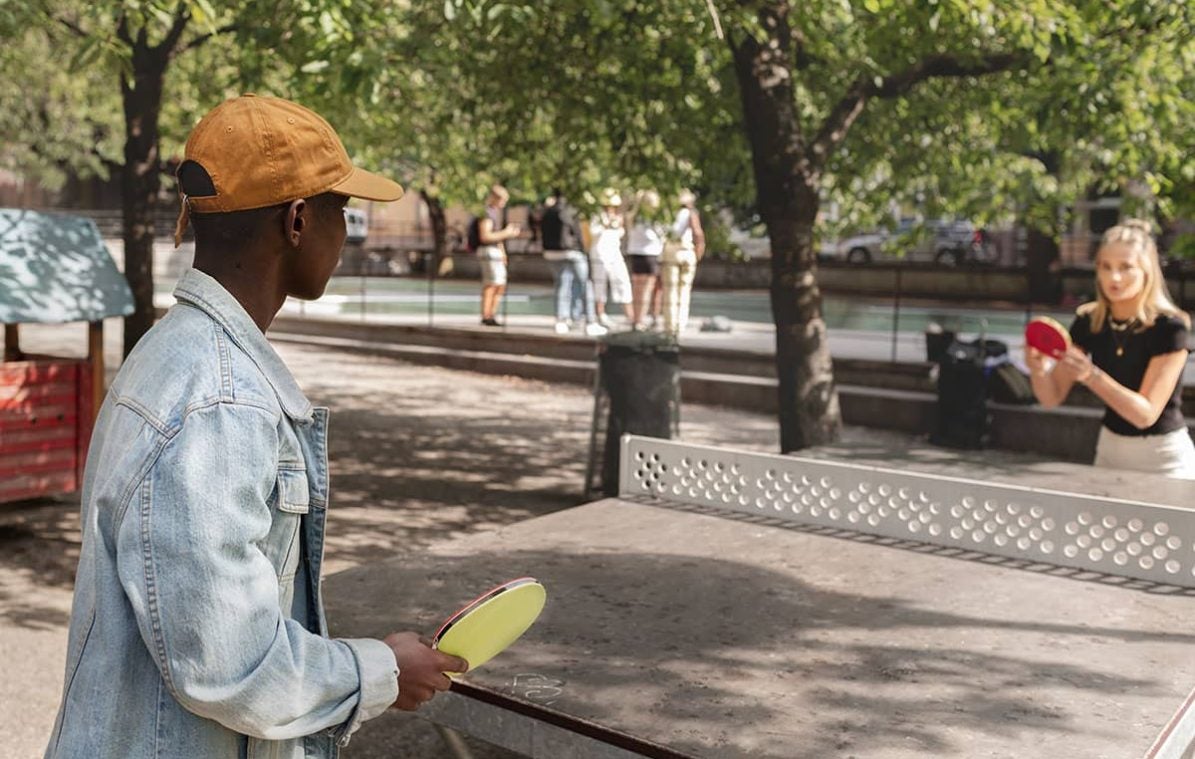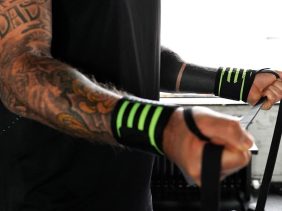The Secret Joy of Trying a New Sport
 © foodspring
© foodspring
Growing up, no one would have called me sporty. Asthma kept me from ever being picked first in gym class, and the fear of breaking my neck ensured I never even attempted a cartwheel. It’s not that I was an indoor kid (I fenced, hiked, swam, and often joined my mom and dad on the tennis and racquetball courts), but no one would have said I was a naturally gifted athlete. Even now, though I’m rarely the sportiest one in the group, I am known for my competitive streak. It’s what fuels my Wednesday night regattas, bombing down snowboarding runs, and early morning weight lifting sessions. And so it was a surprise even to me when I found myself staring down one of Paris’s many public ping pong tables, laser-focused on that little neon ball getting caught in the late afternoon breeze.
I picked up this sport on a whim, thanks to a £11.60 impulse buy at Decathlon. I threw the set in my bike basket, then proceeded to tote the paddles around for a few weeks, my handbag filling with the strong, but reassuring smell of never-touched rubber, when I finally found an opponent. The plan had never been to pick up a new sport, or challenge my hand eye coordination, but after a few failed volleys that is exactly what I started doing. It might seem surprising, even cliché, but what’s proven to be the most joyful aspect of the paddle sport was the relative ease with which I could go from absolute beginner to, well, less of a beginner. And I’m not talking weeks. I’m not even talking days. I’m talking a matter of hours.
RELATED: 7 must-try outdoor sports that don’t require any running.
It’s no secret that becoming an ace at a sport takes time, dedication, training, nutrition, energy, this list could go on forever. But as someone who is both not naturally gifted at sports and has a serious competitive streak, it’s hard to start something new for fear of being bad. But, standing with the red paddle in my hand, that is exactly what I did. I tamped down on my anxiety and reminded myself that it’s ok to learn, it’s ok to fail, and, above all, it’s ok to have fun. Because—and don’t be too shocked when I tell you this—there is more to life than winning. As you get older it takes longer to get good at things, but learning can be an end itself. If it wasn’t, no one would start something new. I still remember the first day I went snowboarding. The larger part of the morning was spent sitting on my bottom, freezing through my snow pants, legs wobbling when I managed to cut back and forth on the bunny hill, all while toddlers flew by, displaying no shortage of confidence. That memory surfaced during the Parisian heat wave when I grabbed the paddle and looked at that sneaky neon orange ball. Rather than playing the role of 30-something with a cold butt, instead I channeled all the confidence of a child snowboarder… and I still wasn’t any good.
But practice makes perfect. Or at least proficiency. To get there, I had to adjust my expectations. Instead of trying to win, the goal was to have fun. The person across from me was not my opponent, but my partner. That mindset helped me drop the overpowered serves akin to tennis (that mostly went out anyway) to exhilarating volleys that lasted over a minute. It wasn’t that I became a pro in a matter of hours, but setting aside the need to succeed and focusing on fun allowed me to improve. I wasn’t suddenly doing high intensity cardio like a Table Tennis Pro Athlete, but I was moving, I was laughing, and I was getting better. It challenged my hand-eye coordination and concentration, and I noticed that with some very well-timed tips from my friend (who is basically a ping pong pro) I made fast improvements.
As the lesson that it isn’t always about being good at something was first dawning on me, I felt a bit like a Judas. After all, my work is, in part, about helping people find their peak performance. My industry is one in which people wear their 1 rep max and marathon PRs as a badge of honour. Yes, we welcome beginners, but there is a tacit understanding that the end goal is mastery. But my detour to ping pong has taught me that sometimes it’s important to simply be—to enjoy fitness and sports with childlike awe. Now my paddles parade around the city with me, sneaking into just about any bag, ready to be pulled out at a moment’s notice for a fitness-focused way to pass time with friends, or even a quick volley with an unexpecting stranger.
It’s no surprise that a study from University of Berkley says exercising can make your brain more sensitive to joy, that “our brains change as we age, and adults lose up to 13 percent of the dopamine receptors in the reward system with each passing decade.” But when we exercise, our brains don’t show the same wear and tear. It’s not that my ping pong would count as the cardio you see on the Word Tennis Championships stage, but I was laughing, smiling, and having uninhibited fun—and the science simply proves it. Movement is movement, and if you can disconnect enough to live in the moment, use your body, and enjoy yourself, chances are good that you’ll see the benefits.
Am I a ping pong pro? No. Did I learn a new skill quickly and get the mental and physical benefits? Yes. I still get in my reps in the morning, building my muscles with hard work and Whey Protein. But I’m finding ways to breathe fun into my fitness routine, and my hand eye coordination is thanking me. My success isn’t that I went from zero to hero, my success is knowing I gained a new skill in the time it takes me to binge watch two episodes of Star Trek: The Next Generation. And that is something that has brought me joy, higher daily strain on my Whoop, and a secret satisfaction knowing that if we were picking ping pong teams for gym class, I wouldn’t be picked last.
Find your very own Ping Pong, also know as a fun activity that you can excel at:
How to Skateboard: 7 Tips for Absolute Beginners
If You Want to Surf, These 11 Tips Will Help You Get Started
3 Tips to Finally Master Push-Ups
A Guide to Pull-up: All You Need to Know
Learn How to do a Handstand: 9 Steps to Flip Your World
Sources for this article
We at foodspring use only high-quality sources, including peer-reviewed studies, to support the facts within our articles. Read our editorial policy to learn more about how we fact-check and keep our content accurate, reliable, and trustworthy.






















